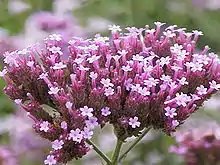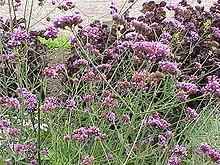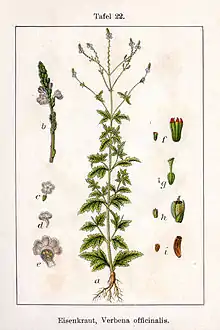| Verbena | |
|---|---|
 | |
| Purpletop vervain, Verbena bonariensis | |
| Scientific classification | |
| Kingdom: | Plantae |
| Clade: | Tracheophytes |
| Clade: | Angiosperms |
| Clade: | Eudicots |
| Clade: | Asterids |
| Order: | Lamiales |
| Family: | Verbenaceae |
| Genus: | Verbena L.[1] |
| Type species | |
| Verbena officinalis L. | |
| Species | |
|
See text | |
| Synonyms[2] | |
| |
Verbena (/vərˈbiːnə/),[3] also known as vervain or verveine, is a genus in the family Verbenaceae. It contains about 150 species of annual and perennial herbaceous or semi-woody flowering plants. The majority of the species are native to the Americas and Asia; however, Verbena officinalis, the common vervain or common verbena, is the type species and native to Europe.
Naming
In English, the name Verbena is usually used in the United States and the United Kingdom, whereas elsewhere the terms verveine or vervain are in use.[4]
Description
Verbena is an herbaceous flowering plant, belonging to the Verbenaceae family, and may be annual or perennial depending on the species. The leaves are usually opposite, simple, and in many species hairy, often densely so. The flowers are small, with five petals, and borne in dense spikes. Typically some shade of blue, they may also be white, pink, or purple, especially in cultivars.[5]
The genus can be divided into a diploid North American and a polyploid South American lineage, both with a base chromosome number of seven. The European species is derived from the North American lineage. It seems that verbena as well as the related mock vervains (Glandularia) evolved from the assemblage provisionally treated under the genus name Junellia; both other genera were usually included in the Verbenaceae until the 1990s.[6] Intergeneric chloroplast gene transfer by an undetermined mechanism – though probably not hybridization – has occurred at least twice from vervains to Glandularia, between the ancestors of the present-day South American lineages and once more recently, between V. orcuttiana or V. hastata and G. bipinnatifida. In addition, several species of verbena are of natural hybrid origin; the well-known garden vervain/verbena has an entirely muddy history. The relationships of this close-knit group are therefore hard to resolve with standard methods of computational phylogenetics.[7]
Cultivation

Some species, hybrids and cultivars of verbena are used as ornamental plants. They are drought-resistant, tolerating full to partial sun, and enjoy well-drained, average soils. Plants are usually grown from seed. Some species and hybrids are not hardy and are treated as half-hardy annuals in bedding schemes.[8]
They are valued in butterfly gardening in suitable climates, attracting Lepidoptera such as the Hummingbird hawk-moth, Chocolate albatross, or the Pipevine swallowtail, and also hummingbirds, especially V. officinalis, which is also grown as a honey plant.
The hybrid cultivars "Silver Anne"[9] and "Sissinghurst"[10] have gained the Royal Horticultural Society's Award of Garden Merit.
Pests and diseases
For some verbena pathogens, see List of verbena diseases. Cultivated verbenas are sometimes parasitized by sweet potato whitefly (Bemisia tabaci) and spread this pest to other crops.
Uses
Although verbena ("vervain") has been used in herbalism and traditional medicine, usually as an herbal tonic, there is no high-quality evidence for its effectiveness.[11] Verbena has been listed as one of the 38 plants used to prepare Bach flower remedies,[12] a kind of alternative medicine promoted for its effect on health. According to Cancer Research UK, "essence therapists believe that using essences can help to increase your mental, emotional and spiritual wellbeing. However, essences are not used to prevent, control, or cure cancer or any other physical condition."[13]
The essential oil of various species, mainly common vervain, is traded as "Spanish verbena oil". Considered inferior[14] to oil of lemon verbena (Aloysia citrodora) in perfumery,[11] it is of some commercial importance for herbalism.
In culture

Verbena has long been associated with divine and other supernatural forces. It was called "tears of Isis" in ancient Egypt, and later called "Hera's tears". In ancient Greece it was dedicated to Eos Erigineia. The generic name is the Latin term for a plant sacred to the ancient Romans.[15][16] Pliny the Elder describes verbena presented on Jupiter altars; it is not entirely clear if this referred to a verbena rather than the general term for prime sacrificial herbs.
Nulla tamen Romae nobilitatis plus habet quam hiera botane. aliqui aristereon, nostri verbenacam vocant. haec est quam legatos ferre ad hostes indicavimus; hac Iovis mensa verritur, domus purgantur lustranturque. genera eius duo: foliosa, quam feminam putant, mas rarioribus foliis.[17] |
No plant however is so renowned among the Romans as hiera botane ('sacred plant'). Some call it aristereon, and Latin writers verbenaca. This is the plant which I mentioned as carried to the enemy by envoys. With this the table of Jupiter is swept, and homes are cleansed and purified. There are two kinds of it; one has many leaves and is thought to be female, the other, the male, has fewer leaves.[18] |
| —Pliny the Elder, Naturalis Historia Liber XXV, LIX | —translated by Harris Rackham |
Pliny the Elder notes "the Magi especially make the maddest statements about the plant: that [among other things] a circle must be drawn with iron round the plant".[18] The common names of verbena in many Central and Eastern European languages often associate it with iron. These include for example the Dutch IJzerhard ("iron-hard"), Danish Læge-Jernurt ("medical ironwort"), German Echtes Eisenkraut ("true ironherb"), Slovak Železník lekársky ("medical ironherb"), and Hungarian vasfű ("iron grass").
In the early Christian era, folk legend stated that V. officinalis was used to staunch Jesus' wounds after his removal from the cross. It was consequently called "holy herb"[19] or (e.g. in Wales) "Devil's bane".[20]
According to the Wiccan writer Doreen Valiente, Vervain flowers signify the goddess Diana and are often depicted on cimaruta, traditional Italian amulets.[21] In the 1870 The History and Practice of Magic by "Paul Christian" (Jean-Baptiste Pitois) it is employed in the preparation of a mandragora charm.[22] The book also describes its antiseptic capabilities (p. 336), and use as a protection against spells (pp. 339, 414).[23] Romani people use vervain for love and good luck.[24]
While common vervain is not native to North America, it has been introduced there and for example the Pawnee have adopted it as an entheogen enhancer and in oneiromancy (dream divination), much as Calea zacatechichi is used in Mexico.
An indeterminate vervain is among the plants on the eighth panel of the New World Tapestry (Expedition to Cape Cod).[25]
In the Victorian language of flowers, verbena held the dual meaning of enchantment and sensibility.[26]
In pop culture
Vervain appears in the CW's show The Vampire Diaries, where the plant acts as a poison against vampires,[27] much like garlic does in pop culture. In the show's lore, vervain was an essential component in the creation of the species.[28]
Species
The following species are accepted:[2] (See also Aloysia, Glandularia and Junellia for species formerly placed here.)
- Verbena alata Otto ex Sweet
- Verbena alejandrana (B.L.Turner) Christenh. & Byng
- Verbena × allenii Moldenke
- Verbena amoena Paxton
- Verbena andalgalensis Moldenke
- Verbena angustilobata (Moldenke) Christenh. & Byng
- Verbena araucana Phil.
- Verbena aristigera S.Moore
- Verbena atacamensis Reiche
- Verbena aurantiaca Speg.
- Verbena bajacalifornica Moldenke
- Verbena balansae Briq.
- Verbena barbata Graham
- Verbena berteroi (Meisn.) Schauer
- Verbena × bingenensis Moldenke
- Verbena bipinnatifida Schauer
- Verbena × blanchardii Moldenke
- Verbena bonariensis L. – purpletop vervain, clustertop vervain, tall verbena, pretty verbena, South American vervain
- Verbena brachyrhynchos (G.L.Nesom & Vorobik) Christenh. & Byng
- Verbena bracteata Cav. ex Lag. & Rodr. – prostrate vervain, large-bracted vervain
- Verbena brasiliensis Vell. – Brazilian verbena, Brazilian vervain
- Verbena cabrerae Moldenke
- Verbena californica Moldenke – California vervain, Red Hills vervain
- Verbena calinfera G.L.Nesom
- Verbena canadensis (L.) Britton
- Verbena canescens Kunth – gray vervain
- Verbena caniuensis Moldenke
- Verbena carnea Medik.
- Verbena carolina L.
- Verbena catharinae Moldenke
- Verbena cheitmaniana Moldenke
- Verbena chiricahensis (Umber) Moldenke
- Verbena × clemensiorum Moldenke
- Verbena cloverae Moldenke
- Verbena corymbosa Ruiz & Pav.
- Verbena cuneifolia Ruiz & Pav.
- Verbena dalloniana Quézel
- Verbena × deamii Moldenke
- Verbena delicatula Mart. & Zucc.
- Verbena delticola Small ex Perry
- Verbena demissa Moldenke
- Verbena dissecta Willd. ex Spreng.
- Verbena dusenii Moldenke
- Verbena ehrenbergiana Schauer
- Verbena elegans Kunth
- Verbena × engelmannii Moldenke
- Verbena ephedroides Cham.
- Verbena falcata G.L.Nesom
- Verbena filicaulis Schauer
- Verbena flava Gillies & Hook.
- Verbena glabrata Kunth
- Verbena gooddingii Briq.
- Verbena × goodmanii Moldenke
- Verbena goyazensis Moldenke
- Verbena gracilescens (Cham.) Herter
- Verbena gracilis Desf.
- Verbena grisea B.L.Rob. & Greenm.
- Verbena guaibensis (P.Peralta & V.Thode) Christenh. & Byng
- Verbena guaranitica (Tronc.) Moldenke
- Verbena gynobasis Wedd.
- Verbena halei Small – Texas vervain
- Verbena hassleriana Briq.
- Verbena hastata L. – swamp verbena, blue vervain
- Verbena hatschbachii Moldenke
- Verbena herteri Moldenke
- Verbena hirta Spreng.
- Verbena hispida Ruiz & Pav.
- Verbena humifusa Cham.
- Verbena × illicita Moldenke
- Verbena incompta P.W.Michael
- Verbena intermedia Gillies & Hook.
- Verbena jessicae Nesom & G.S.Hinton
- Verbena jordanensis Moldenke
- Verbena kuntzeana Moldenke
- Verbena laciniata (L.) Briq.
- Verbena landbeckii Phil.
- Verbena lasiostachys Link – western vervain
- Verbena lilacina Greene
- Verbena lilloana Moldenke
- Verbena lindbergii Moldenke
- Verbena lindmanii Briq.
- Verbena lipozygioides Walp.
- Verbena litoralis Kunth – seashore vervain
- Verbena livermorensis B.L.Turner & G.L.Nesom
- Verbena lobata Vell.
- Verbena macdougalii A.Heller
- Verbena macrosperma Speg.
- Verbena madrensis G.L.Nesom
- Verbena malmii Moldenke
- Verbena malpaisana (T.Van Devender & G.L.Nesom) Christenh. & Byng
- Verbena maritima Small
- Verbena marrubioides Cham.
- Verbena megapotamica Spreng.
- Verbena mendocina Phil.
- Verbena menthifolia Benth. – mint vervain
- Verbena microphylla Kunth
- Verbena moctezumae G.L.Nesom & T.Van Devender
- Verbena × moechina Moldenke
- Verbena montevidensis Spreng. – Uruguayan verbena
- Verbena moranii G.L.Nesom
- Verbena multiglandulosa Moldenke
- Verbena nana Moldenke
- Verbena neomexicana (A.Gray) Briq. – hillside vervain
- Verbena officinalis L. – common vervain, simpler's joy, holy herb, mosquito plant, wild hyssop, herb of the cross (type species)
- Verbena × ostenii Moldenke
- Verbena ovata Cham.
- Verbena paraguariensis Moldenke
- Verbena paranensis Moldenke
- Verbena parodii (Covas & Schnack) Moldenke
- Verbena paulensis Moldenke
- Verbena perennis Wooton – pinleaf vervain
- Verbena × perriana Moldenke
- Verbena × perturbata Moldenke
- Verbena peruviana (L.) Britton
- Verbena phlogiflora Cham.
- Verbena pinetorum Moldenke
- Verbena platensis Spreng.
- Verbena plicata Greene
- Verbena polyantha (Umber) Moldenke
- Verbena porrigens Phil.
- Verbena pumila Rydb.
- Verbena quadrangulata A.Heller
- Verbena racemosa Eggert
- Verbena radicata Moldenke
- Verbena recta Kunth
- Verbena rectiloba Moldenke
- Verbena regnelliana Moldenke
- Verbena reitzii Moldenke
- Verbena ribifolia Walp.
- Verbena rigida Spreng. – tuberous vervain
- Verbena rugosa Mill.
- Verbena × rydbergii Moldenke
- Verbena sagittalis Cham.
- Verbena santiaguensis (Covas & Schnack) Moldenke
- Verbena scabra Vahl – sandpaper vervain
- Verbena scabrella Sessé & Moc.
- Verbena scrobiculata Griseb.
- Verbena selloi Spreng.
- Verbena sessilis (Cham.) Kuntze
- Verbena simplex Lehm. – narrow-leaved vervain
- Verbena sphaerocarpa L.M.Perry
- Verbena stellarioides Cham.
- Verbena stricta Vent. – hoary vervain
- Verbena strigosa Cham.
- Verbena × stuprosa Moldenke
- Verbena subincana (Tronc.) Shinners
- Verbena sulphurea D.Don
- Verbena supina L.
- Verbena tampensis Nash
- Verbena tecticaulis Tronc.
- Verbena tenera Spreng.
- Verbena teucriifolia M.Martens & Galeotti
- Verbena thymoides Cham.
- Verbena tomophylla Briq.
- Verbena townsendii Svenson
- Verbena tumidula L.M.Perry
- Verbena turneri (G.L.Nesom) Christenh. & Byng
- Verbena tweedieana Niven ex Hook.
- Verbena urticifolia L. – white vervain
- Verbena × uruguayensis Moldenke
- Verbena valerianoides Kunth
- Verbena venturii Moldenke
- Verbena verecunda (Umber) Moldenke
- Verbena villifolia Hayek
- Verbena xutha Lehm. – gulf vervain
Gallery
 Verbena obsession cascade pink
Verbena obsession cascade pink Large-bracted Vervain (V. bracteata)
Large-bracted Vervain (V. bracteata)
 Verbena speciosa
Verbena speciosa Superbena® Scarlet Star or Superbena® Raspberry
Superbena® Scarlet Star or Superbena® Raspberry Hoary Vervain (V. stricta)
Hoary Vervain (V. stricta)
References
- ↑ "Genus: Verbena L." Germplasm Resources Information Network. United States Department of Agriculture. 2004-01-29. Retrieved 2011-08-29.
- 1 2 "Verbena L." Plants of the World Online. Board of Trustees of the Royal Botanic Gardens, Kew. Retrieved 14 May 2021.
- ↑ Western Garden Book. Sunset Books. 1995. pp. 606–07.
- ↑ "Amazing Benefits of Verveine Tea: Is This a Miracle Tea?". Tea Reviews. Archived from the original on 2021-06-13. Retrieved 19 November 2022.
- ↑ "Year of the Verbena". National Garden Bureau. 2021-10-19. Retrieved 2022-06-22.
- ↑ S. M. Botta; S. Martinez & M. E. Mulguta de Romero (1995). "Novedades nomenclaturales en Verbenaceae" [Nomenclatural revisions in Verbenaceae]. Hickenia. 2: 127–128.
- ↑ Yao-Wu Yuan & Richard G. Olmstead (2008). "A species-level phylogenetic study of the Verbena complex (Verbenaceae) indicates two independent intergeneric chloroplast transfers". Molecular Phylogenetics and Evolution. 48 (1): 23–33. doi:10.1016/j.ympev.2008.04.004. PMID 18495498.
- ↑ RHS A-Z encyclopedia of garden plants. United Kingdom: Dorling Kindersley. 2008. p. 1136. ISBN 978-1405332965.
- ↑ "RHS Plant Selector Verbena 'Silver Anne' (G) AGM / RHS Gardening". Apps.rhs.org.uk. Archived from the original on 2012-12-24. Retrieved 2013-05-06.
- ↑ "RHS Plant Selector Verbena 'Sissinghurst' (G) AGM / RHS Gardening". Apps.rhs.org.uk. Archived from the original on 2012-12-24. Retrieved 2013-05-06.
- 1 2 "Vervain". Drugs.com. 2009. Retrieved 7 March 2018.
- ↑ D. S. Vohra (1 June 2004). Bach Flower Remedies: A Comprehensive Study. B. Jain Publishers. p. 3. ISBN 978-81-7021-271-3. Retrieved 2 September 2013.
- ↑ "Flower remedies". Cancer Research UK. Retrieved 11 November 2016.
- ↑ "Verbena". frontend. Retrieved 2022-06-22.
- ↑ Quattrocchi, Umberto (2000). CRC World Dictionary of Plant Names, Volume 4: R-Z. Taylor & Francis US. p. 2787. ISBN 978-0-8493-2678-3.
- ↑ Gledhill, D. (2008). The Names of Plants (4th ed.). Cambridge University Press. p. 399. ISBN 978-0-521-86645-3.
- ↑ Pliny the Elder. Naturalis Historia. pp. Liber XXV, Section LIX.
- 1 2 Pliny the Elder. Natural History. pp. Book 25, Section 59.
- ↑ Watts, D. C. (2007). Dictionary of Plant Lore. Elsevier. p. 197. ISBN 9780080546025.
- ↑ "Aconitum uncinatum (Appalachian Blue Monkshood, Blue Rocket, Devil's Helmet, Eastern Blue Monkshood, Eastern Monkshood, Monkshood, Southern Blue Monkshood, Wild Monkshood, Wolf's Bane) | North Carolina Extension Gardener Plant Toolbox". plants.ces.ncsu.edu. Retrieved 2022-06-22.
- ↑ Valiente, Doreen (1994). An ABC of Witchcraft Past and Present. The Crowood Press. ISBN 9780719826917.
- ↑ Pitois, Christian (1952). The History and Practice of Magic, Volume 2, Forge Press. p. 402.
- ↑ Pitois, (1952) pp. 336, 339, 414
- ↑ Gerina Dunwich (September 2019). Herbal Magick: A Guide to Herbal Enchantments, Folklore, and Divination. Weiser Books. ISBN 9781633411586.
- ↑ "New World Tapestry". Mayflower 400. 17 February 2020. Archived from the original on 16 July 2021. Retrieved 16 July 2021.
- ↑ "Language of Flowers - Flower Meanings, Flower Sentiments". www.languageofflowers.com. Retrieved 2016-11-26.
- ↑ Vampire Diaries_ Damon Gets Poisoned With Vervain, retrieved 2023-11-20
- ↑ Rebekah Tells How Her Family Turned Into Vampires - The Vampire Diaries 3x08 Scene, retrieved 2023-11-20
External links
 Media related to Verbena at Wikimedia Commons
Media related to Verbena at Wikimedia Commons